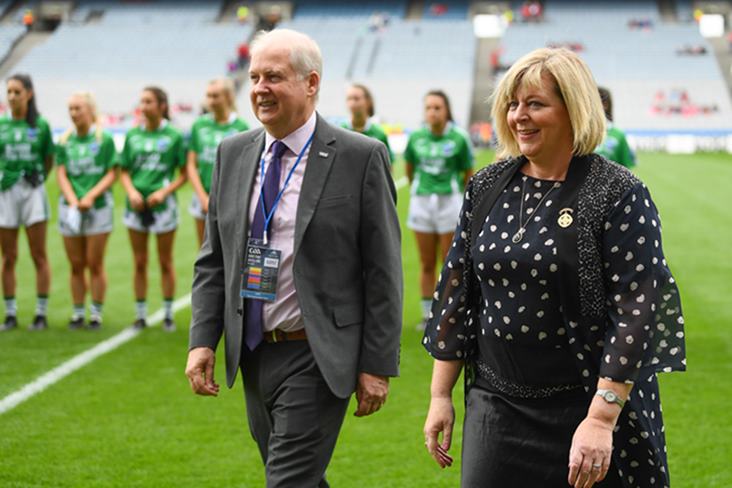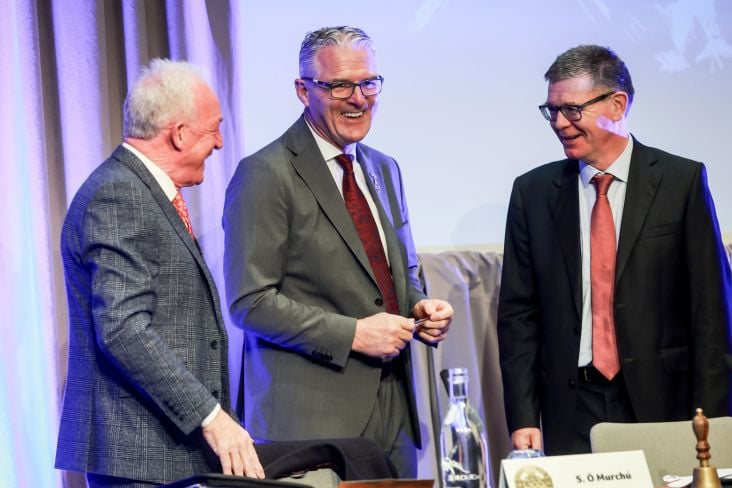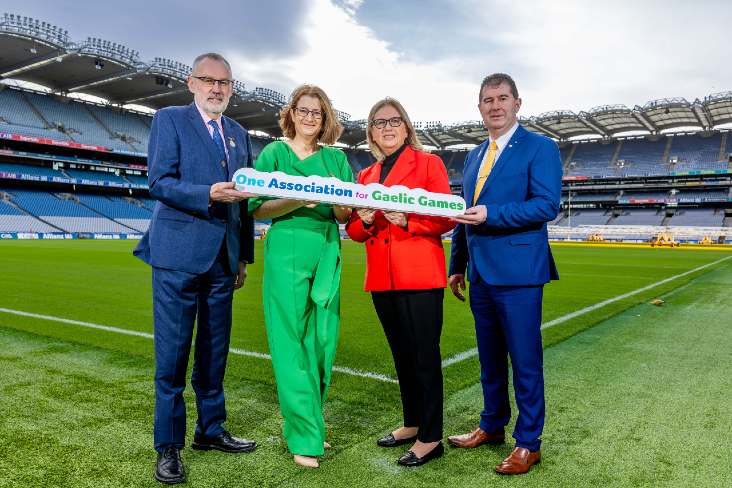"We hear about the great play and the bad play, it's like normal GAA coverage"
December 20, 2019
Alan Esslemont, Ardstiúrthóir TG4 and LGFA President Marie Hickey
By Declan Rooney
Marie Hickey is in her fifth year as President of the Ladies Gaelic Football Association, and with less than a year and a half to go in her tenure, she says there are still plenty of things left for her to achieve before she vacates the post.
A Chemistry and Biology teacher in St Kevin’s Community College in Clondalkin, Hickey is a native of Ballylinan in Co Laois, and she currently lives in Kildare. She continues to be a member of her home club, where she was a founding member in 1983. Since then, she has been involved in coaching teams right through the age grades, as well as club and provincial administration before she became national President in 2015.
The new LGFA President will be elected next March at Annual Congress, before taking on the role officially in March 2021.
DR: Marie, how has your time as President been as an experience?
MH: I’m nearly five years in the role now and it has been amazing. At the start, you don’t know what to expect. The level of commitment is huge, the time required is massive but the sense of fulfilment from it is also incredible.
You are going to different clubs, venues and events and you get to see what’s happening at the grassroots. You see the work that volunteers are doing around the country, and that’s my favourite part of the role.
What were your main aims when you took the job?
The growth of the game in the last six or eight years has been phenomenal. It was always in my head that I wanted to see players recognised and to see their efforts promoted correctly. It used to bug me when I’d see some articles, but now it’s all about the players and their skills. We hear about the great play and the bad play, it’s like normal GAA coverage.
A big thing for us now is the live streaming of many of our games on Facebook. It means everyone can watch the games wherever you are around the world and that has helped in the recognition that our game is a good, skilful game to watch.
I was down at Féile this year and for the first time when listening to the kids they were talking about their favourite football players being women. Because they are able to see their heroes, now they can aspire to doing it themselves.
We have a new championship structure in 2020. Why has the format changed?
The structure has been tweaked from what we had in 2019. One idea was for the TG4 All-Ireland Series not to be dependent on the provincial championships, but we decided that wouldn’t be the case. Central Council voted for the new structure to be implemented.
The fact that Dublin are on their own in Leinster as a Senior county and that Down and Clare are also on their own in their provincial Intermediate competitions, you want to be able to facilitate all counties to have as many games as possible.
Some managers have recently suggested that video replays are being used to make on-field decisions. Is that now or has it ever been the case in the LGFA?
Score assistants have been in use in the LGFA since after the 2016 TG4 All-Ireland Final. Dublin lost that game by a point and they had a score disallowed before half-time, which should have been allowed. When that happened, we asked how we could improve the situation. Central Council decided to have the referee linked to an official watching the live feed to determine if there was anything wrong with a score – but it’s there to assist the referee with scores only. The score assistant is only in operation for Live TV games.
Is there concern that All-Ireland Final attendances are influenced recently by Dublin’s presence?
Obviously the fact that Dublin have been in the last few finals brings an extra crowd because it’s on their doorstep, but there are more and more coming from other counties as well. This year we had more clubs coming to the All-Ireland finals at Croke Park from non-participating counties than ever before. That’s great to see.
This year we had our semi-finals in Croke Park and we had nearly 11,000 there, which was a big increase. The venue has a lot to do with it too, and the timings of throw-ins are important, that there are no clashes. We are seeing increases and I think it is better if it’s a gradual increase. I think it will be sustained better that way.
Do you see a correlation between the participation numbers and attendances in general?
It was really heartening on the weekend of the club finals, we had the biggest crowd ever at the club finals. That really shows us that support is on the increase across the board.
You’d be hoping that we can sustain those attendances over a long period of time because with the promotion of the game, the sponsors getting behind us, it means we have a greater reach and greater retention rates now at underage levels. Definitely into the future, if we can keep even half of the girls that we had previously been losing and keep them playing at U-16, Minor and into adult football, the numbers are going to continue to increase.
I think that because more young girls can see women as their role models, that will help us too. Players are more visible to young girls now, they can see them on live at games, on TV and on social media and that all encourages them all to stay on and aspire to play too.
How has the LGFA’s relationship with the GAA evolved over the years?
It is something that always needs to be worked on. We have one-club models operating and that works very well and everyone has integrated very well. In some places, ladies teams are still struggling to access facilities and that can be difficult at times, it’s tough to get venues and county grounds for their games. But it is hugely improved since the Memorandum of Understanding was signed in early 2018.
It is something that is conscious in everyone’s mind that if a merger is going to happen in the future, the key thing is how we manage to pull it together to make it suit nearly everybody – you won’t always be able to suit everyone. We want to get the best result for our players out of it.
Why is the sport so attractive to sponsors?
TG4 have been incredible supporters of ladies football and next year is the 20th anniversary of our sponsorship deal. Their coverage has evolved with our game. It started off with the All-Ireland finals in 2001 and it has gone from strength to strength since then.
When Lidl came on board, TG4 were amazing. They wanted to develop the whole sponsorship deal as a partnership. At our All Stars and the All-Ireland finals, both sponsors’ branding is there, even though Lidl sponsor the National League and TG4 are our Championship sponsors. Both parties are happy to work together instead of vying for space and coverage.
Is Australian Rules Football a threat to the Ladies game or a carrot for players?
It’s a mixed thing, really. It’s a great opportunity for players to go and participate at that level, to experience the lifestyle over there. A lot of young people like to travel, to see different parts of the world. If you can go and play football at the same time, isn’t that wonderful for you as a player? It is a dream come true I suppose.
My concern is that the Australian game is a tough game and it’s getting tougher. The worry is that our players will pick up injuries that might knock them out of action for a while. More girls than before have gone over this year, and I suppose it would turn into a threat to our game if they start staying over there long term. It’s all of our top players that are going over and their counties really don’t want to lose them
Tweet








